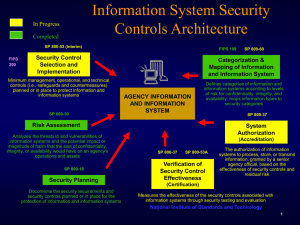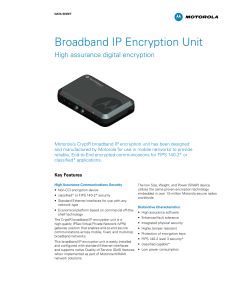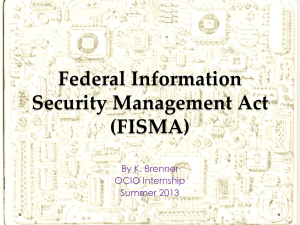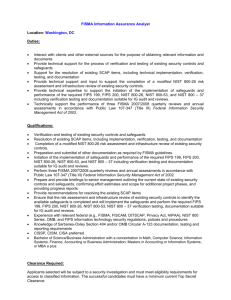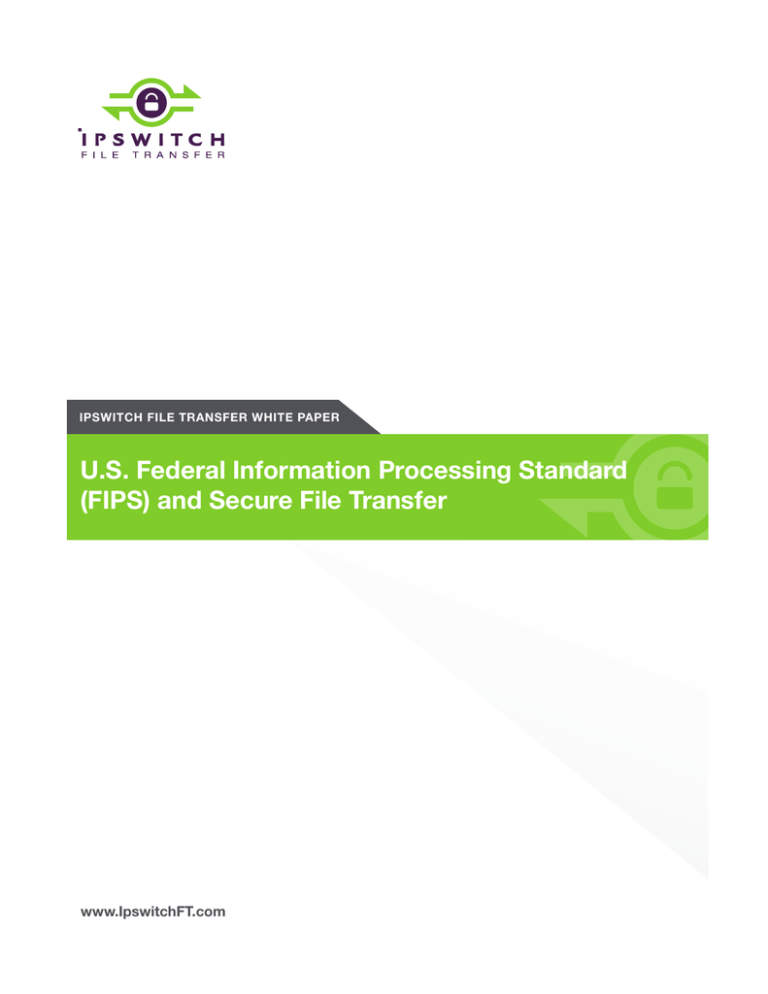
IPSWITCH FILE TRANSFER WHITE PAPER
U.S. Federal Information Processing Standard
(FIPS) and Secure File Transfer
www.IpswitchFT.com
FIPS 140-2 is a standard first published in 2001 by the U.S. National Institute of Standards and Technology (NIST), a non-regulatory
agency of the U.S. Department of Commerce. NIST works to establish various standards that the U.S. military and various
government agencies must abide by. Vendors, contractors, and any organization working with government or military must comply
with FIPS as well. The Canadian government also has policies requiring FIPS-validated software, and it cooperates with NIST in
establishing FIPS standards.
FIPS includes standards regarding the formatting of location and personal identification information, encryption algorithms, key
storage, and other data processing areas. FIPS purpose is to ensure the security, quality, and processing compatibility of various
services in an easily-verified way. This whitepaper will mostly concern
itself with FIPS 140-2, which covers the encryption requirements
applicable to Ipswitch’s file transfer products.
What Does FIPS 140-2 Require?
In cases where a high level of security is required, a FIPS-validated
data-transmitting application must 1) use algorithms and hash functions
approved by FIPS 140-2, and 2) be validated by the Cryptographic Module
Validation Program (CMVP). The CMVP is a testing process under the
supervision of the U.S. NIST and the Communications Security
Establishment (or CSE, which serves as NIST’s validation functions
in Canada).
A FIPS-validated solution must use cryptographic algorithms and hash
functions approved by FIPS. The following are three examples of such
approved algorithms:
• AES (Advanced Encryption Standard) is a new algorithm adopted
by NIST in 2001. It is stronger than Triple DES (Data Encryption
Standard) when using greater key strength.
• Triple DES a variant of IBM’s 56-bit DES encryption that uses three
keys for a total of 168-bit strength. Triple DES was approved by
NIST for use in 1999.
• HMAC SHA-1 is a cryptographic hash function designed by the
FOUR LEVELS OF FIPS
SECURITY
Level 1
According to the FIPS specification, “allows
the software and firmware components of
a cryptographic module to be executed on
a general purpose computing system using
an unevaluated operating system.” Users
can run this level of security on ordinary
hardware.
Level 2
Requires role-based authentication, seals
that provide evidence of any physical
tampering, and includes requirements
regarding the software’s operating system.
Level 3
Adds a number of requirements to Level 2,
including physical tamper resistance.
Level 4
Adds more stringent tamper resistant
requirements, plus resistance to
environmental hazards.
National Security Agency (NSA). It authenticates messages and is
deployed in combination with a secret key.
FIPS and Secure File Transfer
1
FIPS will not approve certain other encryption algorithms, such as the
original 56-bit DES encryption developed three decades ago.Other
algorithms which are considered too weak by recent standards include the
very popular MD5, a widely-used cryptographic hash function known to
contain flaws, and CRC32, which is not a true data encryption method.
You can view the FIPS 140-2
specification at:
csrc.nist.gov/publications/fips/fips1402/fips1402.pdf
Validation – The Key Differentiator in FIPS
Many solutions claim to be “FIPS compliant.” This phrase is simply a claim that the solution aligns with FIPS requirements. To truly
comply with FIPS, however, the solution needs to be FIPS validated. FIPS validation involves submitting detailed documentation
and source code to NIST’s testing laboratories. In most cases, the testing process takes several months (6-9 months, on average).
Consequently, creating FIPS-validated solutions not only involves using approved algorithms, but also providing software that is
well documented, well engineered, and tested, and also is easily testable in ways that help move the validation process forward in
a timely way.
NIST not only tests the software operationally, but also checks for security flaws, such as the incorrect use and disposal of keys in
memory, and the predictability of “random” number generation. It also verifies the presence of module self-integrity checks
(which prevent tampering), and checks for possible back doors and hardcoded keys. It is important to note that with file transfer
software, both client and server applications must be validated. Other systems and processes involved in the software’s operation
must be validated as well.
The validation process is sufficiently complex that entire software solutions have concerned themselves with creating documented,
test-ready source code for third-party companies implementing FIPS. Therefore, for the reasons stated above, only a handful of
file transfer products presently include FIPS-validated cryptography and processing.
Who Requires FIPS?
The military and its vendors, who often deal in sensitive national security information are frequently required to abide by FIPS.
Federal and state government agencies that deal with citizens’ private information must also comply.
Government vendors who require privacy with regard to personal and financial information can include financial institutions,
information-processing vendors, healthcare-related vendors, educational institutions, and utilities. Vendors who deal with national
security commonly include manufacturers and a wide variety of military contractors.
However, the FIPS standard is still relevant to companies not required to comply with government encryption regulations. As
stated above, FIPS validation involves subjecting software to rigorous testing to determine whether flaws are present. Hence,
solutions without this validation are more likely to contain vulnerabilities.
FIPS and Secure File Transfer
2
One example of vulnerability was found recently in versions of the Debian and Ubuntu operating systems. It was found that the
output of these systems’ random number generators could be predicted, presenting a significant security flaw. Since the NIST
specifically checks for this flaw during its validation process, it is unlikely that the flaw would have existed if the operating systems
had been subject to NIST tests.
Ipswitch File Transfer’s Solutions
WS_FTP® Server family
Using OpenSSL FIPS (an open source project sponsored by Hewlett Packard, the DoD Military Health System, and the Open-Source
Software Institute), WS_FTP Server’s FIPS module supports AES (up to 256-bit), Triple DES, and HMAC SHA-1 encrypted transfer.
WS_FTP Server’s encryption transfer, integrity checking (FTP, HTTP, and HTTPS), HTTPS transport, FTP commands, and data-stream
encryption are all validated under the FIPS-validated module. These all use AES encryption for transaction privacy and HMAC
SHA 1 for data-integrity checking. WS_FTP’s solution is validated by FIPS certificate 918, with specific protocols validated by 613,
668, 701, and 352 (under the OSSI’s Open SSL).
MOVEit™ product family
Ipswitch’s MOVEit File Transfer and MOVEit Central applications both use FIPS-validated AES and SHA-1 for encryption. MOVEit’s
validation falls under 140-2 certificate 310, with specific protocols validated by certificates 30 and 124. (Incidentally, all certificates
mentioned here are recognized both in the US and Canada.)
MOVEit File Transfer
MOVEit File Transfer uses FIPS-validated modules for file encryption, HTTP and HTTPS, FTP integrity checking, and
encryption of sensitive database fields. Together with a FIPS-validated Windows operating system, MOVEit File Transfer
also uses a FIPS-validated encryption for HTTPS transport, FTP commands, and data-stream encryption.
MOVEit Central
MOVEit Central also uses FIPS-validated encryption for encryption of configuration files, and for HTTP, HTTPS, and
FTP integrity checking (which uses both a MOVEit proprietary integrity check as well as a standard XSHA1). With a
FIPS-validated Windows operating system, MOVEit Central is also FIPS-validated for HTTPS transport encryption, FTP
command, and data stream encryption.
FIPS and Secure File Transfer
3
Conclusion
Ipswitch’s WS_FTP Server, MOVEit Central, and MOVEit File Transfer deliver a set of FIPS-validated solutions that meets or exceeds
FIPS 140-2 standards. A FIPS validation is difficult to obtain, but it is a necessity for many government agencies and the military, as
well as many vendors who regularly deal with those entities. Additionally, FIPS’s lengthy and rigorous testing process is an excellent
quality indicator for other parties looking for a secure file transfer solution.
With WS_FTP Server’s long history of secure file transfer, and MOVEit’s track record of a successful FIPS solution, Ipswitch File
Transfer’s products are a thoroughly dependable component of any organization’s file transfer solution—both for organizations
requiring FIPS and organizations that do not.
Ipswitch File Transfer provides solutions that move, govern and secure business information between employees, business partners and
customers. The company’s proven solutions lead the industry in terms of ease of use, allowing companies of all sizes to take control of their
sensitive and vital information and improve the speed of information flow. Ipswitch lets business and IT managers govern data transfers and
file sharing with confidence and enable compliance by balancing the need for end user simplicity with the visibility and control required
by IT. Ipswitch File Transfer solutions are trusted by thousands of organizations worldwide, including more than 90% of the Fortune 1000,
government agencies, and millions of prosumers. For more information on Ipswitch File Transfer and its products, go to www.IpswitchFT.com.
FIPS and Secure File Transfer
4
Copyright © 2013, Ipswitch, Inc. All rights reserved. MOVEit is a registered trademark of Ipswitch, Inc. Other products or company names are or may be trademarks or registered trademarks and are the propery of their respective holders.
WP_FIPS_201309_v20

